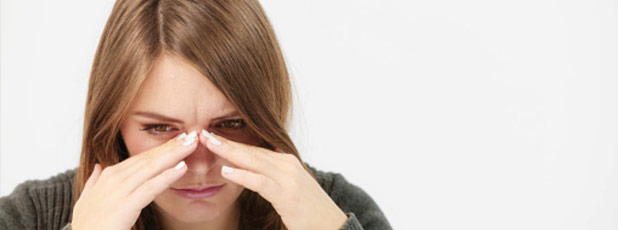
Almost all sinus problems begin inside the nose. The sinuses (described in detail below) connect with the internal lining of the nose via small tubes. These tubes must stay clear otherwise sinus obstruction occurs, leading to various unpleasant and stubborn medical conditions. Throughout this text, and especially at the end, there are photographs showing what damaged and diseased nose and sinus problems look like. Patients of whatever age with long standing nose and sinus problems worsen during the change of seasons March/April and September/October.
Nose and sinus problems are among the most frequent causes of visits to the doctor. Equally nose and sinus problems can be lightly dismissed because they (usually) do not pose any great risk of serious ill health. Commonly the family doctor will base his treatment on the patient’s self-diagnosis (“my sinuses are acting up” or “my sinuses are killing me” or “I’ve had this dreadful sinus headache for days” or variations of this). An antibiotic with or without a nasal decongestant is the most likely therapy offered. However recent insights into the importance of the nose and sinuses, especially their link to asthma, suggest nose and sinus problems have to be taken seriously and individual treatments carefully planned.
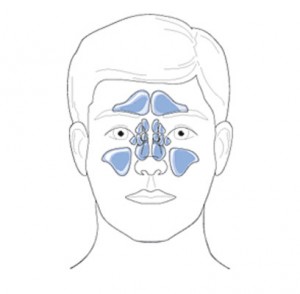
Beside and below are diagrams of where the sinuses are located.
Sinuses are cave-like pockets in the skull and are lined with much the same material as our respiratory tracts. The function of sinuses is uncertain but theories include humidifying air, providing cushioning for the skull and increasing resonance of the voice. Cynics claim sinuses only exist to make ENT surgeons and allergists rich!
Sinuses can become inflamed as a result of infection or an allergic challenge. Tiny hairs along the respiratory tract push mucus up towards our nose and mouth. When the lining of the sinuses swells this mucus becomes stuck and causes uncomfortable pressure. It also produces a perfect breeding ground for bacteria.
There are four types of sinuses found on the face called the maxillary, frontal, sphenoid and ethmoid. When each (or all) is inflamed from infection or allergic challenge different symptoms are experienced.
What might I experience when my sinuses become inflamed or infected?
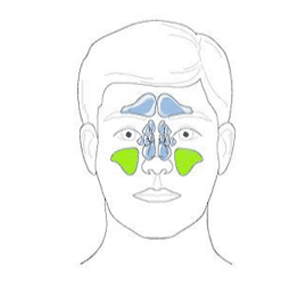
The green colour marks the maxillary sinuses, located just behind the cheekbones on the face. If you have an inflammation of the maxillary sinuses you may experience:
- Cheek pain/pressure
- Toothache
- Headache
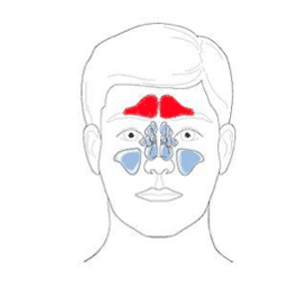
The red colour identifies the frontal sinuses, located just above the bone at the centre of each eyebrow. If you have an inflammation of the frontal sinuses you may experience:
- Pain around and behind the eyes
- Headaches
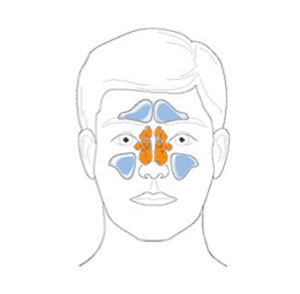
The orange colour identifies the ethmoid and sphenoid sinuses. The ethmoids are located between the eyes and just behind the bridge of the nose. Behind the ethmoid sinuses, tucked in behind the eyes are the sphenoid sinuses. If you have an inflammation of either or both you may experience:
- Pain/pressure between and behind the eyes
- Headaches

17 year old male with long history of nasal obstruction, headaches and runny nose. Photo shows grossly swollen nasal lining obstructing the sinus openings. X-ray showed that the ethmoid and maxillary sinuses were thickened from long term obstruction.
Other symptoms associated with Sinusitis:
- Prolonged cold with a stuffy nose
- Green, yellow or blood streaked mucus coming from the nose
- Pain in the head that worsens when lying back-down or bending over
The condition of Rhinitis (ailment of the nose) is associated with Sinusitis as the inflammation of the nose (streaming and persistent sneezing amongst other symptoms) can progress into the adjoining sinuses.
Diagnosing various forms of Sinusitis:
Sinusitis can be classified in several different forms, mostly characterised by duration.
- Acute Sinusitis (duration of 4 weeks)
- Chronic Sinusitis (duration of 12 weeks or more)
- Fungal Sinusitis (very important cause and one that researchers are studying in great detail. In the US some specialists believe as much as 90% of long standing sinusitis is due to fungal infection)
Acute Sinusitis (lasting up to 4 weeks):
Acute Sinusitis is usually the result of a viral upper respiratory tract infection and comes on as a result of bacteria ‘settling’ on to virally damaged tissues. It can also begin as a result of a fungal infection (more common amongst diabetics or people with immune deficiencies) or in relation to dental problems affecting the maxillary sinus. The duration of the ailment is normally the key to discovering whether a patient is suffering from short-term or long-term sinusitis but biopsies (in the case of the presence of fungus) and CT scans (special X-Rays) are also used to assist diagnosis.
Chronic Sinusitis (symptoms lasting longer than 4 weeks):
Chronic sinusitis is complicated because there may be a number of inter-related causes. The phrase multi-factorial is used here and the different factors include allergy, environmental irritants such as dust or pollution, cigarette smoke, cocaine abuse, bacterial infection, or fungus (either allergic, infective, or reactive). Structural defects such as abnormally small narrow sinus passages and even hormone changes or certain medications can also lead to chronic sinusitis. Chronic sinusitis tends to have more vigorous symptoms including fever, green or yellow nasal discharge, blurred vision and intense headache. CT scans and Nasal Endoscopies (see below) are often used to clarify the situation.
Naso-endoscopy involves inserting a flexible fiberoptic tube with a light and camera at its tip into the nose to examine the nasal passages and sinuses. This is generally a painless procedure which takes between 5 to 10 minutes to complete.

Olympus ENF type V2 fiberscope for inspecting the nose, sinuses, back of nose and throat.
In the digital image below there is severe swelling of all the lining in the nasal cavity causing symptoms such as blockage, mouth breathing, diminished sense of smell and taste and ‘wheeziness’. Treatment involves first restoring the nasal lining to normal, then stabilising the area and deciding what the cause is. In this case it was an aggressive allergy to dust mites and grass pollens. This patient would benefit greatly from a new treatment called Rhinolight U/V phototherapy combined with immunotherapy (full details elsewhere in this website).

Grossly distorted, swollen and fluid-filled nasal lining.
Fungal Sinusitis:
Fungal Sinusitis was once considered a rarity but may be more common than previously realised. Symptoms are often similar to those of bacterial sinusitis and the fungal infection may trigger fleshy (benign) growths inside the nose called polyps. People who are allergic to fungi are often more susceptible to this particular form of sinusitis. A CT scan commonly determines whether or not a fungal infection has occurred and standard procedures such as endoscopic surgery are considered to clear the offended fungus and resume normal sinus drainage.

Nose polyps. These are benign fleshy, grape-like growths that form inside the nose and sinuses. There is no agreement on the causes of nose polyps but some US researchers believe that an allergic response to fungal spores may be one explanation.
Treatments:
Antibiotic medications are used to treat acute sinusitis. These medications are usually given for about two weeks, but aggressive sinusitis may require longer courses. Decongestants, or the short-term use of decongestant nose sprays, can be useful. Analgesics decrease the associated pain and headache. Also, running a humidifier can prevent mucus within the nasal passages from drying out uncomfortably, and can help soothe any accompanying sore throat or cough.
Chronic sinusitis is often treated initially with antibiotics. Steroid nasal drops and sprays may be used to decrease swelling in the nasal passages. If an anatomic reason is found for chronic sinusitis, it may need to be corrected with surgery. If a surgical procedure is necessary, samples are usually taken at the same time to identify any organisms present which may be causing infection.
Fungal sinusitis will require surgery to clean out the sinuses. Then, a relatively long course of a strong antifungal medication may be offered.
Allergic nose and sinus issues my now be treated using the latest non-medical technique Rhinolight (read more about this in the About the Clinic section of this website)
We take your sinus issues seriously. When you attend you will be quizzed about symptoms such as:
- Snoring
- Mouth breathing
- Dry mouth every morning after sleep (suggesting night time mouth breathing)
- Runny nose
- Post nasal drip
- Blood stained mucus
- Diminished (or lost) senses of smell and taste
- Associated asthma or shortness of breath or night cough
- Associated skin hives (medical term is urticaria)
- Aspirin or dispirin or similar pain killer allergy
This information gives us valuable insights as to what type of sinus problem you have. We then inspect the nose and sinuses with an Olympus ENF fiberscope (see photo below). This is a 3mm in diameter fiberoptic instrument that allows us visually check the breathing tract from the tip of the nose to the vocal cords. Our fiberscope is connected to an LCD screen that allows the patient follow the procedure. The screen can display an image ‘freeze’ so we can discuss an area of particular importance.
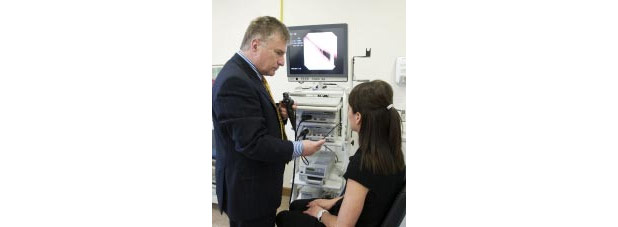
Olympus fiberscope in action. The flexible tip measures 3 mms and passes easily along the nose, into the back of the throat and down to the vocal cords. On the screen all areas can be viewed. Specific zones of interest can be photographed and recorded to assess treatment strategies. This has been used on children as young as 5 years and adults over 80 years.
We combine this with a full allergy screen.
Cost
Full allergy test and fiberoptic assessment of the nose, sinuses and throat: €290. Follow up fee where necessary is €70
Rhinolight® treatment charge:
- The options are to pay-as-you-go (€140 each treatment session) or buy and pay at time of booking for a package of 6 or 8 treatments (1 free treatment in these packages). Reduced price packages MUST be paid for at time of booking. The minimum number of Rhinolight® treatments is 6.
- 1 treatment costs €140
- 6 treatments cost either €140 ‘pay-as-you-go’ (total cost €840) or the 6 treatment ‘pay-at-time-of-booking-and get-one -free’ package of €700.
- 8 treatments cost either €140 pay-as-you-go’ (total cost €1120) or the 8 treatment ‘pay-at-time-of-booking-and get-one -free’ package of €980.
As a guide: 6 treatments would be advised for the seasonal allergy hay fever while 8 treatments would be recommended where there are all-year-round symptoms such as occurs with allergy to dust mite and pollens (this includes animal hair allergy).
Below are examples of images we captured on patients illustrating just how troublesome their sinus problems were at the first consultation.

25 year old with the internal surface of the nose so allergically challenged fluid is beginning to swell the lining. Left untreated the shiny bubble-like area at 8 o’clock will become a polyp. In long standing nose and sinus allergic challenge, if an infection sets in ON TOP of the background changes considerable extra damage can be inflicted on the soft tissue.

A nasal polyp. This is a benign but nuisance growth inside the nose that causes symptoms of obstruction, loss of senses of smell and taste and may trigger asthma.

Even in children as young as 5 years considerable swelling can occur within the nasal cavity. This in turn obstructs the sinus openings causing sinus problems. And in turn this may trigger off asthma. If the nose and sinus problems are corrected the asthma usually abates significantly.